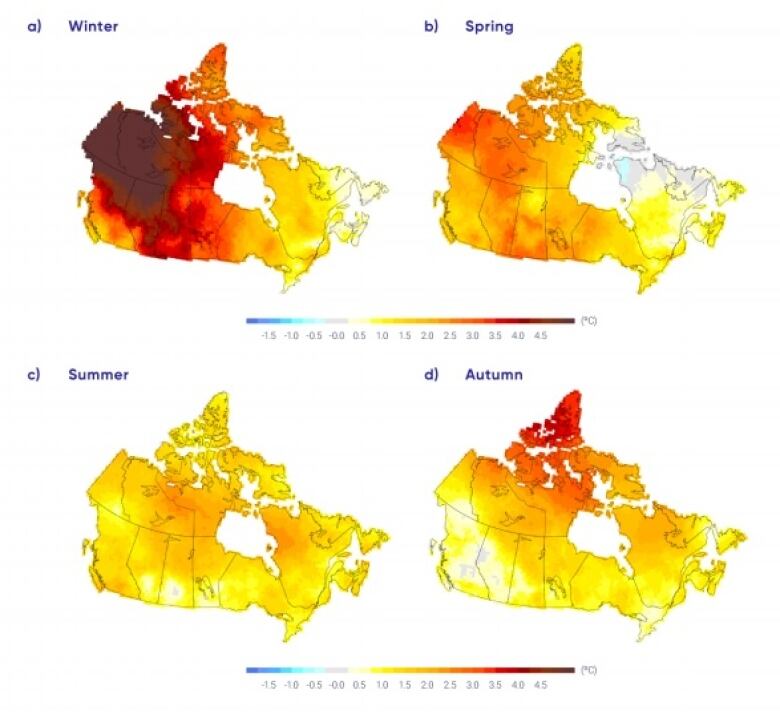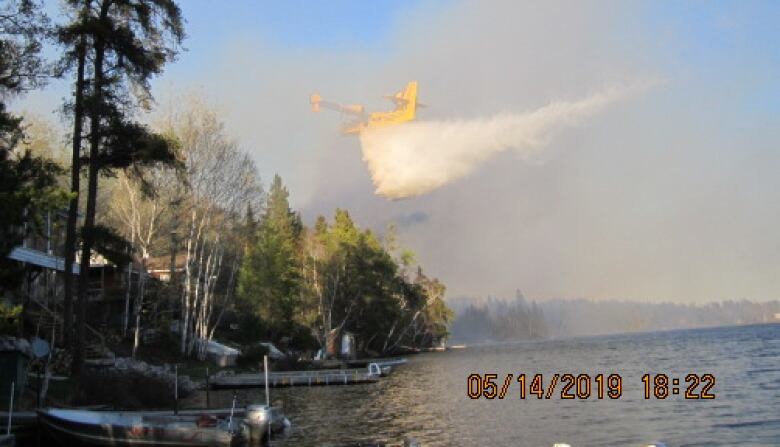Earlier, later and less predictable: How the forest fire season is changing and why
Climate change has made western Canada warmer. It's also increased the risk of more severe forest fires.

Duringa supper hour in the middle of May, Ingolf, Ont., storekeeperLise Lyons looked overLongpine Lake and watched a forest fire consume an A-frame cabin in a matter of minutes.
"It was just a big red ball of fire. It was amazing. I don't think I've ever seen a building go up that fast," said Lyons, recalling theMay 14 fire that briefly threatened her cottage communitynear the Manitoba-Ontario border.
As the flames consumed the forest between the lakefront and the Canadian Pacific Railwayline,Lyons preparedto leave her property behind.
"I was sitting on my pontoon boat, with my dog and my suitcase packed, thinking we were going to be evacuated any time," she recalled.

She didn't have to flee. Water bombers arrived to douse the fire, which posed an early-season test for the volunteer firefightersof Ingolf, which sits just two kilometres east of Manitoba's Whiteshell Provincial Park.
They're not alone. Across much ofCanada and particularly in the west firefighters and forest managers are forced to contend with woodland blazesfor a longer portion of the year, as climate change has pushed the start of fire season up to the edge of winter, extended it into the fall and made the entireseason less predictable.
"It seems to be starting earlier,almost every year, and quite oftenit's before the provinces actually have their staffing up for their wildfire initial attack teams," said Bruce Morrison, chief of the volunteer Southeast Whiteshell Fire Department.
"We're seeing fires happening in April because,you know,boom the sun hits," he said in an interview from West Hawk Lake, the Whiteshell town where he runs both a restaurant and the fire hall across the road.
"[Once] the snow pack's gone, thenext thing you know,within a week, it'scrunching underfoot and that's why we've seen a number of flare-ups over the last number of years."
Dave Schafer, Manitoba's new fire program director, said the fire season is also lasting longer in the fall.
"We're seeing things are less predictable. We're seeing more extremes at both ends of it," said Schafer, who started his career fighting forest firesand has returned to fire management after serving as the provincial fire commissioner.
Manitoba is by no means alone, as Albertaand B.C. can painfully attest in recent years. Alberta has moved the start of its wildfire season up to March 1 to get in front of increasingly frequent late-winter fires.
Climatologists and forest experts are all butcertain of the cause of the longer, less predictable and more extreme fire season: Canada is getting warmer.

While the entire countryis warming at twice the rate of the planet as a whole, average temperatures are rising even faster in the western provinces and the north, and particularly duringthe winter.
A federal climate change report released in April concluded the average annual temperature in the Prairie provincesrose 1.9C between 1948 and 2016, while the average winter temperature in Manitoba, Saskatchewan and Alberta has risen by 3.1 C.
The warmer weather has led to drier conditions in both forests and grasslands earlier in the season, andan increased incidence of summer lightning.
Worst of all, it's also led to a greaterfrequency of the hot, arid and windy"fire weather" that spawns the most destructive fires,said Mike Flannigan, a wildland fire professor at the University of Alberta in Edmonton.
3 ingredients for a forest fire
Flannigan, one the leading experts on the relationship between climate change and forest fires, said there are three ingredients for any fire.
For starters, fuel needs to be present. In some areas of Alberta and B.C., there's alarger potential stockpile of fuel because some forests have grown thicker due to a century offire-prevention efforts. The Rockiesare also homestands of bone-dry trees killed by the mountain pine beetle, which has marched further north and up to higher altitudes because ofless frigid winterweather.
In Manitoba, the foresthasn'tchanged in this manner. The mountain pine beetle has yet to arrive here and the forest cover is just as thick in most portions of the province today as it was prior to European colonization.
"This is a common misconception," he said. "For our boreal forest, this kind of changeover really doesn't happen."

The second ingredient for a fire is ignition and that has changed, Flannigan said.
While people are responsible for lighting about 60 per cent of forest fires, the lightning that causes the remaining 40 per cent sparksfires that are responsible for 80 to 90 per cent of the area burned by forest fires, he said.
Even worse, lightning is becoming more frequent due to warmer weather, he said, citing U.S. work that suggests each degree of warming leads to 10 or 12 per cent more strikes.
"All things being equal, more lightning means more fire," Flannigan said. "Actually, things aren't equal, because as we warm, the atmospheregets more efficient at sucking the moisture [from]the fuel.
"This is really critical because the drier the fuel, the easier it is for fires to start to spread. And perhaps most importantly, it means more fuels available to burn,which means it's higher intensity, which means it can be difficult to impossible to put out through direct attack."

The third ingredient for fire is weather and this is where Flannigan has even worse news. The potential for"fire weather," or periods of unusual heat combined with low precipitation and high winds, has increased, partlybecause any given set of weather conditions can hang around longer thanbefore.
The jet streamwhich used to flow quickly due to the difference in temperature between cold, northern regions and warmer southernareas has slowed due to a smaller differential, he said. And that means high-pressure systems, free of any moisture, can hang around for longer periods of time.
"Instead of a fast-flowing river carrying the lows and highs, it's a slow-moving, lazy river with meanders,eddies and whirlpools. So those lows and highs get stalled and stuck," Flannigan said of the jet stream. "Then you get drought and fires."
Climate-change models predicted more extreme weatheron the Prairies, a midcontinental region where weather was already highly variable, said Danny Blair, a University of Winnipeg geography professor and the science director at the Prairie Climate Centre.
"This is what's feared to happen more often in the future," he said. "Or perhaps now."
Flannigan is more committal about the cause of recent changes.
"For Canada and the western United States,I'm 100 per cent confident that these are due to climate change in terms of area burned," he said.
"And in terms of the impact on society, it's a combination of the changing climate in addition to more people living and working in the forest."
Manitoba spared the worst, for now
In recent years, Manitoba has not sufferedthe extremely destructive fires on the scale of the Fort McMurray blaze in Alberta in 2016.
Manitoba hasadvantages over Albertain the form of fewer large population centres in forested areas and more lakes large enoughto allow water bombers to load up.
The last devastating fire year in Manitoba took place in 1989, during the second consecutive summer of high heat and unusual drought. Almost four million hectares of the province burned that summer, according to the Canadian Wildland Fire Information System.

"We haven't seen anything near what 1989 was,but it doesn't mean we're out of the woods either. We're paying attention to what's happening in Alberta," said Schafer, the Manitoba fire program director.
"Fires, looking across Canada in general, are getting larger and that's what we need to be prepared for."
Manitoba was one of the first jurisdictions in North Americato ban backcountry travel during fire weather. Flannigan said measures like this do reduce the potential for people starting fires.
But he also advocates changes to urban-planning and construction practices to reduce the impact of fires. The absence of fire guards bands of property without forest coveraround towns all increase the chance of property damage from forest fires, he said.
Wooden shingles on homes and the use of peat or mulch as landscaping are also bad ideas.
"I've seen homes burn down just because they have mulch around their driveway. It's like a wick takes [the fire] right to the house," he said.
Every remote community needs two ways in and out, added Schafer, both to ensure people can flee a forest fire and water supplies can get in, he said.
Morrison, the Southeast Whiteshell fire chief, also warned cottagers to store firewood at least 30 metres away from any structure.
"I think people are just not wanting to walk that far to get their wood," he said.
People and urban planners all need to adjust, Flannigan said."It's not popular, but we have to learn tolive with fire," he said.

Back in Ingolf, the new reality is not popular, at least when it comes to the frequency of forest fires.
"We have a fire every single year. It just hasn't stopped," said Lyons, the storekeeper who watched a cottage burn last month.
All of Ingolf was evacuated in 2016, when the Caddy Lake fire in Manitobawasthreatening to push east.
Firefighters and favourable weather stopped that blaze, but even the small fire this May left scars in what used to be the forest behind the lakefront.
"I walk back there and it's nothing but black sticks," Lyons said. "It looks terrible."
With files from Jacques Marcoux and Roberto Rocha













_(720p).jpg)


 OFFICIAL HD MUSIC VIDEO.jpg)
.jpg)



























































































